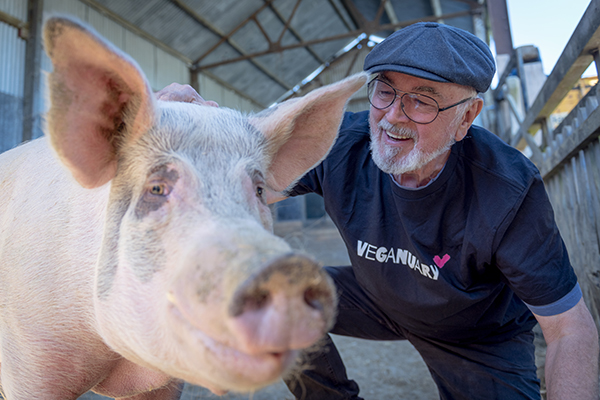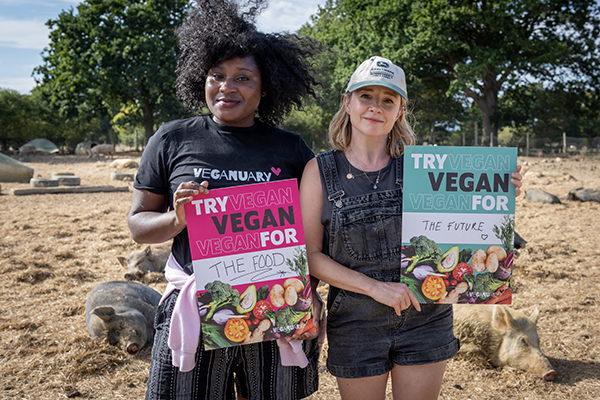 British actor, Peter Egan
British actor, Peter Egan
What is Veganuary?
Veganuary – the UK-based charity inviting people to pledge to be vegan every January – may be familiar to many, almost becoming a normal feature of the cultural calendar. In fact, research shows that over three-quarters of people in the UK have heard of Veganuary. But its rapid expansion may be surprising. The brainchild of its founders Jane Land and Matthew Glover, Veganuary began with just 3,300 sign-ups in 2014. Since then, it’s mushroomed (no pun intended!) to 1.8 million people being directly supported by Veganuary in 2024, and an estimated 25 million worldwide choosing to try Veganuary in 2024. As well as individual Veganuary sign-ups, employers also participate in Veganuary’s Workplace Challenge, with 115 UK organisations participating in 2024, including ‘Universities, colleges, councils, insurance companies, NHS Trusts, charities and train companies’ (Veganuary 2024 campaign report).
What impact is Veganuary having?
But does the growth of Veganuary itself translate into meaningful social change? Psychologist Chris Bryant argues that it does. For instance, he reports research that sales of vegan items in workplace cafeterias participating in Veganuary increased by ‘86–113% in the 2019-2022 campaigns’. Increased sales were sustained beyond the end of Veganuary, suggesting a lasting impact, and being echoed by increased vegan sales in supermarkets and grocery stores. 25% of Veganuary participants report intending to remain vegan, indicating that Veganuary may be playing a significant role in the recent rapid increase in the number of self-identified vegans: around 150,000 (0.25% of the UK population) in 2014, rising to around 1.8 million (3% of the UK population) by 2021, according to Ipsos Mori and YouGov polls respectively.
 British actors, Susan Wokoma (left) and Rebecca Callard (right)
British actors, Susan Wokoma (left) and Rebecca Callard (right)
On the face of it then, Veganuary appears to be achieving some success in implementing its mission: ‘…to inspire and support people to try vegan […] with the aim of ending animal farming, protecting the planet and improving human health’ (Veganuary 2024 campaign report). Veganuary’s mission also appears to align with the motivations of participants: in 2022, 44% of Veganuary participants cited ‘animals’, 21% ‘personal health’ and 19% ‘the environment’ as their main motivation. For Bryant, the biggest Veganuary motivation being ‘animals’ is significant, as evidence suggests that opposition to their harmful exploitation is widespread and that messages about ‘animal cruelty’ are most persuasive in dissuading people from eating animals.
How can we explain Veganuary’s success?
The alignment of Veganuary’s mission with the motivation of participants suggests that the campaign resonates with many people. In other words, Veganuary seems to provide a way for people to live, or take action, according to what already matters to them, rather than seeking to change people. For Bryant, Veganuary’s success has also been bolstered by two factors. Firstly by tying in with the traditional optimistic adoption of new year habits (Veganuary’s website invites vegan-curious people to ‘join the new year’s revolution’). And secondly its social dimension, with participants able to share the experience with others. Making veganism a sociable, communal experience has been a concern of the modern vegan movement since its inception 80 years ago (Cole, 2014), and so Veganuary seems to have gone a long way towards cracking that nut! For example, Veganuary in the workplace makes it easier to share vegan meals with colleagues. As the number of vegans and the availability of vegan products increase, the social isolation of individual vegans may become less of a risk. This may be especially helpful given that media coverage of veganism has often tended to be negative in the past, labelling vegans with uncomfortable stereotypes that are thankfully less tenable, as veganism becomes a more normal part of everyday life.
Beyond Veganuary?
If Veganuary and veganism as a whole continue their impressive growth in 2025 and beyond, Bryant argues that we may soon approach a tipping point where veganism is widespread enough to ‘catch on’. However, there are still significant obstacles to overcome. The spectacular success of Veganuary is inspiring but increases in availability and sales of vegan products alone aren’t necessarily enough to reach the tipping point. As I’ve argued previously, with sociologist Kate Stewart, the ‘green rush’ for the vegan consumer pound may obscure the ethical basis for veganism, especially as vegan products are often made by the same companies involved in exploiting and killing nonhuman animals. This is explored in depth in the OpenLearn course Why are nonhuman animals victims of harm? As that course shows, harmful uses of other animals tend to be justified by speciesism – the idea that other animals’ interests are subservient to those of humans – which is an idea that is embedded very deeply in society. Speciesism, and the role that veganism plays in challenging it, is outlined in a free OpenLearn interactive and a short documentary film that shows how vegan animal sanctuaries give us a hopeful glimpse of a post-speciesist future. In that wider context, Veganuary may well be evidence that we as a society are becoming more willing to confront and challenge the harms that other animals experience.




Rate and Review
Rate this article
Review this article
Log into OpenLearn to leave reviews and join in the conversation.
Article reviews